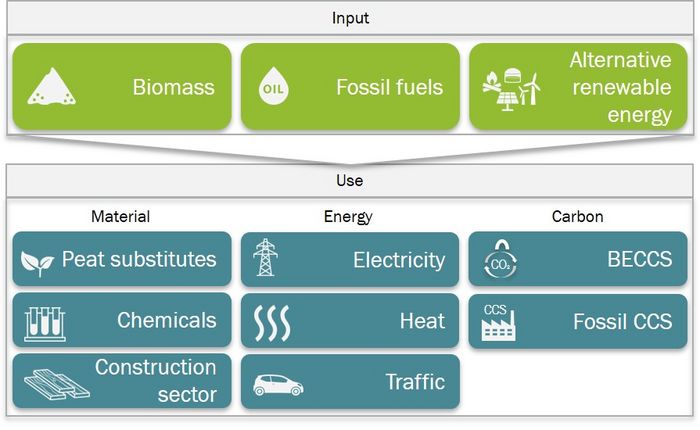Integrated Sectors
The heating sector is divided into 19 sub-sectors based on the general approach of previous analyses. The residential, commercial and industrial sectors are considered. The future development of heat demand in the building sector is based on the results of the Öko-Institut's building stock model, which uses an agent-based approach to model the future renovation of the German building stock at an annual resolution.
The transport sector is further divided into six sub-sectors. For each sub-sector, possible vehicle types and their specific current and future efficiencies are defined. Technically feasible fuel types compete for each vehicle type. The future energy demand for national and international transport in each sub-sector, broken down by calendar year (2020 to 2050), is determined on the basis of the GreenLate scenario of the UBA-RESCUE study. The cost-optimised future development of vehicle types and fuels is determined endogenously for each model.
For the electricity sector, we assume that bioenergy is not competitive with energy from wind and PV. The focus of this study is on the future role of bioenergy competing with other non-fluctuating energy resources in the electricity sector to meet the future residual load. To save modelling resources, the residual load is therefore calculated in advance for each year at hourly resolution, taking into account battery and water storage. This result is used as the residual load requirement for the optimisation, which can be met by 28 technological options. The options considered include combined heat and power (CHP). The heat by-product of each CHP technology is used to some extent to meet the demand in the district heating sector.
The peat substitute sector is small compared to the other sectors, but important for climate protection. The model considers compost from green waste, wood fibres, bark humus, coconut fibres, pine bark and new peat substitutes (spaghnum, fermentation residues from poplar wood) as options for peat substitutes. In some cases, the model incorporates restrictions on import volumes or areas. There is a constraint in the model to replace the use of peat with substitutes by 2030.
A sustainable transformation of the chemical industry is an important part of current efforts. In deciding which chemicals to replace with bio-based alternatives in the model, the focus is on basic chemicals. Methanol, methane, naphtha, ethylene, butanes, propylene, BTX and crude oil for lubricants and surfactants are the building blocks on which almost all organic chemistry is based.
The construction sector consumes relatively many resources and produces emissions that are difficult to avoid. One approach is to increase the proportion of timber construction to reduce emissions. In the model, the demand for wood raw materials and products is modelled in competition with other options such as steel, cement or composite materials. Scenarios are used to analyse targets for the share of timber construction that have not yet been set in legislation.
Various BECCS technology options have been included in the model to reflect CO2 capture and storage ('negative emissions' or 'BECCS') measures and to reflect current discussions on negative emissions technologies, such as those taking place in the development of the Long-Term Negative Emissions strategy (LNe). Several bioenergy options have been combined with CO2 capture in the model: Biomethane plants, bioethanol plants, biomass power plants, heating plants, biogas plants with CHP and gasification plants. While the first two already produce a pure CO2 stream during the process, post-combustion capture is assumed for the latter (the CO2 is captured from a gas stream, e.g. from flue gases). In addition, the option of converting digestate into biochar by pyrolysis has been included for the bioenergy processes in which it is produced, in order to create another permanent carbon sink. In principle, digestate could also be used to produce hydrothermal carbon, but this pathway was not included due to lack of data. The model was also given the option of combining the energy use of biomethane and natural gas in large industrial plants with CO2 capture.
In addition to a detailed presentation of energy subsectors and possible (hybrid) biomass technology concepts, BenOpt also provides a detailed presentation of biomass potentials and prices. As the available data on potentials cannot always be clearly assigned to the same biomass price categories, two different biomass categories have been created in BenOpt: Biomass potential categories and Biomass price categories. This relationship can be illustrated using wood biomass as an example. The annual available potential of forest residual wood is a known quantity, but the price depends on the subsequent processing stage. Wood chips have a different price than pellets, briquettes or logs. In addition to the domestic biomass potential, imported biomass is also taken into account, limited to certain amounts depending on the sector and scenario.

